
|
The Return - June 2008
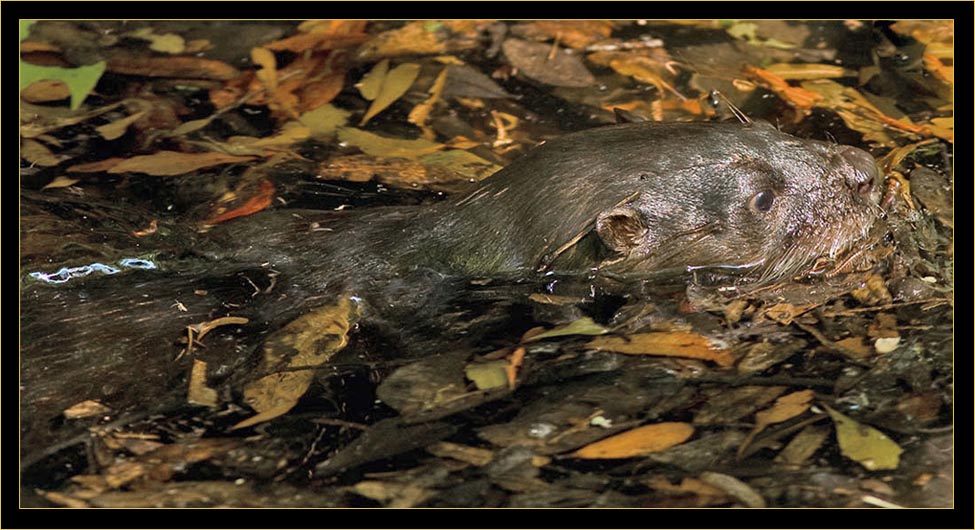
|
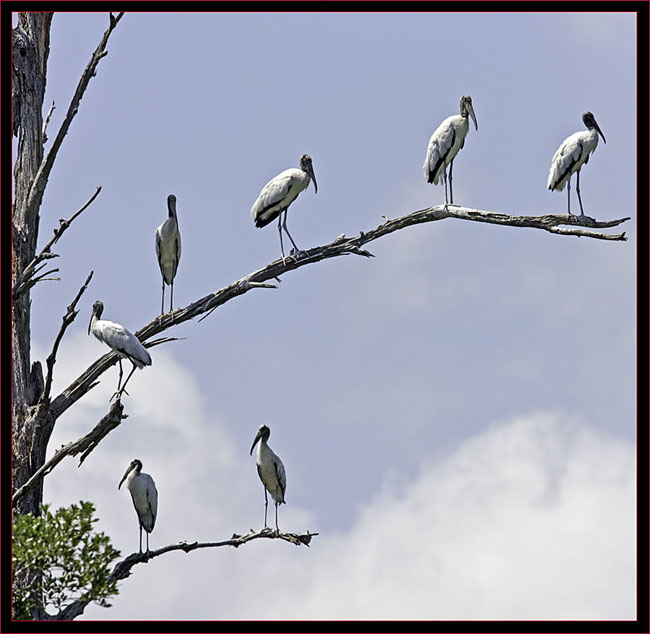
|
This article details photographic efforts on Skidaway Island but I was also active shooting in other locations in Georgia, South Carolina and Florida in the same time period of 2008. I’d joined an astronomy friend & fellow bird photographer,
Ken Schmidt for an extended weekend in the Tallahassee area along with an Audubon group which turned out to be great fun as well as quite a success. I stopped at several prime birding locations on the
drive from Savannah into Florida and did a
series of nature and landscape images. Then there is always the ‘birding on the road’ concept where you may observe something different or unusual while driving along or simply locate a promising spot or refuge to get the cameras out to learn what may
be around - not just birds, anything of interest actually. I obtained some excellent images of a Swallow-tailed Kite in flight this way, a first photographically for me and an event that pleased me greatly.
Wood Stork Group at Priests Landing. This is a two-shot composite stitched in Photoshop CS3. |
|
I arranged my schedule as much as was possible to remain in Maine during the month of May, the premier birding month at home for the spring migration when the warblers come through. I was successful in this effort and even managed to take some time off
work so I could canvass the local hot spots over several weeks. I added a number of new species to my Bird Photography Index from this period. If you take time to view the Index,
scroll down to the bottom of the species listings and you’ll see a tag entitled
‘Special Edition Galleries’ – this contains photo galleries of my bird images by date in the field and includes many photographs of my May efforts.
Red-headed Woodpecker up close at Skidaway Island State Park
Canon 1Ds/600mm lens extended to 840mm on tripod, 1/1000 second, f/8 @ ISO 1000 with flash |
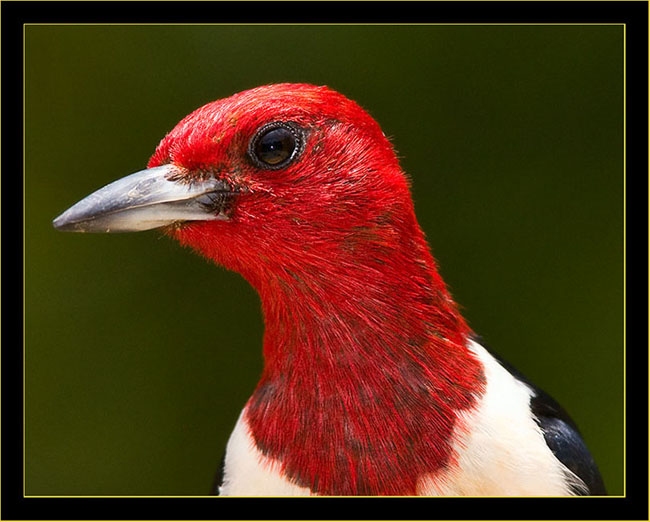
|
A Brief Digression...Again
My grandmother, Florence Elizabeth Youmans, descended from a prominent antebellum family who resided in the Low Country of South Carolina in what was then Beaufort District. Nowadays this area forms a portion of Hampton County, named after Wade Hampton, when the district was converted to a county system in the late 1800’s. The County lies close to equidistant between Charleston and Savannah and I’ve learned the ties to this Georgia city were strong.
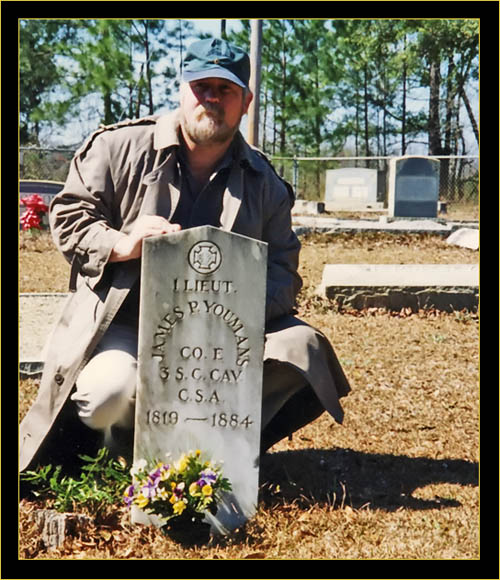
|
If you conduct much ancestral research on this terrible time in our Nation’s history it won’t take long to discover that various companies with a decidedly local composition formed into regiments and went off to war. One such regiment from my area of research
was the Third South Carolina Cavalry and I have multiple Confederate ancestors that served in this regiment, mostly in Companies E, including my great, great grandfather, Lieutenant James Peeples Youmans & F, with multiple Youmans family members.
The 3rd SC Cavalry remained in South Carolina for most of the war and the ten companies did not serve together but were spread out guarding the rail line between Charleston & Savannah. Being in and around Savannah is a genealogical treat for
me as many of the area place names, i.e., Bluffton, Honey Hill, Hardeeville, etc., have come up often in the course of this research.
Now to the point… I was well aware that Company F had been captured in South Newport, Georgia in August of 1864 after they had been detached to monitor Union activities. When driving south on I-95 you travel through South Newport and on one of my trips I diverted off the interstate and drove over to Harris Neck Wildlife Refuge. Following the road to Harris Neck takes one across the South Newport River and close to where the 1864 bridge was burned by a Union incursion up the river. Most of Company F was captured in this skirmish including several of the members of the Youmans family. I was quite surprised to see the historical marker of this event indicated below and was previously unaware about it. Kiro at the gravesite of his grandfather, James Peeples Youmans in 1995; Black Creek Baptist Cemetery,Hampton County, South Carolina. |
|
One of James P. Youmans nephews, Edwin Caruthers Youmans, was captured in the South Newport skirmish, his Combined Service Record from the National Archives indicates the date as August 17, 1864. Edwin was 'admitted to the U.S.A. Post Hospital,
Morris Island, SC, with a complaint of chronic diarrhea, on January 12, 1864, and died, January 15, 1865' (at age 19). I know his cousin, William McBride Chisolm, was also captured with Company F, but survived the war
dying in Hampton County in February 1912. William’s record indicates he appeared on a ‘descriptive list of Rebel prisoners of war transferred from Philadelphia, PA., to Fort Delaware, Del., January 10, 1865, by order of the Military Commander’.
Later he also appears on a Prisoner of
War Register at Fort Delaware, received there January 12, 1865; the last listing in his file is the “Oath of Allegiance”, subscribed to at Fort Delaware, Delaware, which list his place of residence as Beaufort, SC;
(spelled 'Buford' in the documents); he was released June 10, 1865, ending his Confederate war service.
Many of the Company F men ended up in Fort Delaware Prison on Pea Patch Island in the Delaware River, in the southern view one of the most dreaded facilities of all. And many did not survive the harsh conditions – it was sometimes referred to as the ‘Andersonville of the North’. I’ve visited this site and viewed the prison’s most significant monument of all: the 2,436 Confederate graves at Finns Point National Cemetery. Multiple names of 3rd South Carolina Cavalry, Company F members are listed as having died at Fort Delaware Prison. Nowadays the site is Fort Delaware State Park - people frolic about and picnic at the site – the tragedy and devastation of the American Civil War long in the past… Historical marker in South Newport, Georgia
|
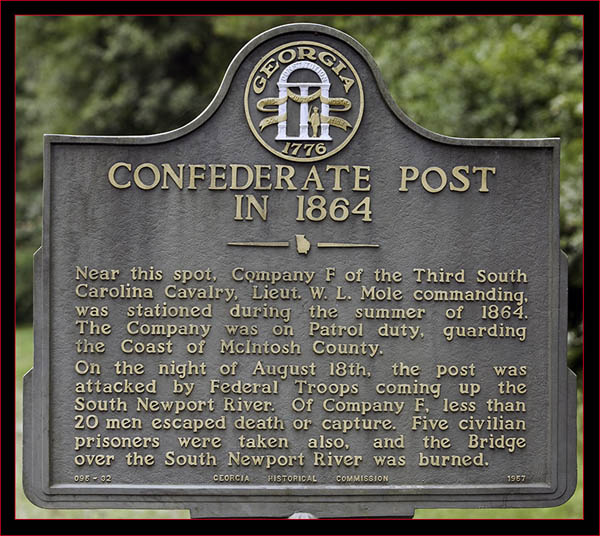
|
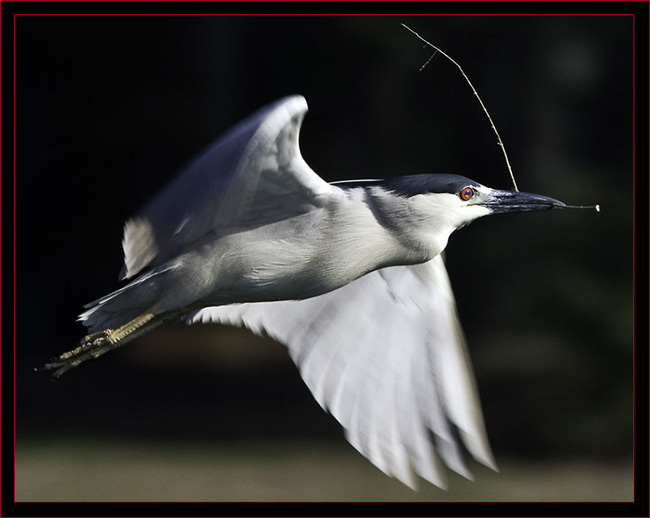
|
My time in Georgia this June wouldn’t be lengthy and I did have business to conduct while in the south. This made photography a secondary concern to the overall effort but I planned to get out with my friends whenever
my schedule permitted. Before it was over I managed this on three or four occasions and planned a three-day weekend for some down time before commencing the return drive. Except for one day-long field trip
we stayed on Skidaway Island for these efforts.
Black-crowned Night-Heron in Flight at the rookery - 1Ds Mark III, 1/250 second @ f/14, ISO 640 at 840mm |
|
While back in Maine during the month of May I remained in contact with my Savannah friends via telephone and email. In some of the emails received I started to read about a new fellow that had been met through photography,
Hunter Kennedy, another resident of The Landings. As most of our correspondence was distributed to all of us collectively, Hunter and I started to correspond a bit and I looked forward to meeting him. I learned that Hunter,
much like Doug & Fitz, is indeed an interesting fellow with a remarkable background from naval officer to university professor. He has an avid interest in photography as well and was organizing a website and
the ‘Photographers Bulletin’, distributed electronically, to share information & knowledge among interested parties around the island.
Wood Stork at the rookery
|
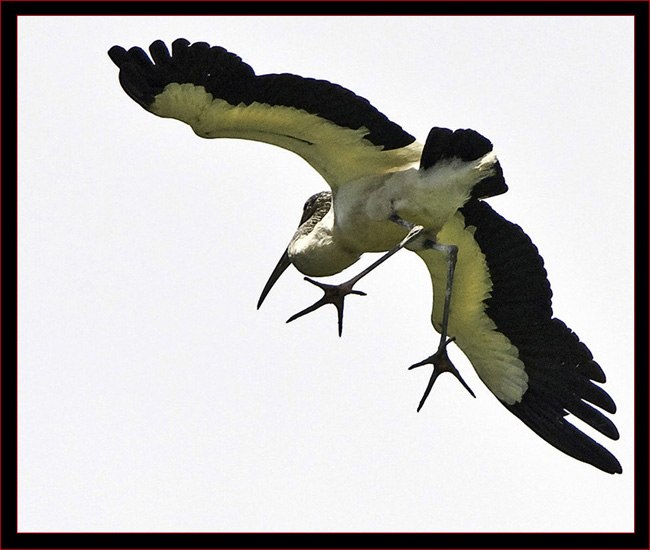
|
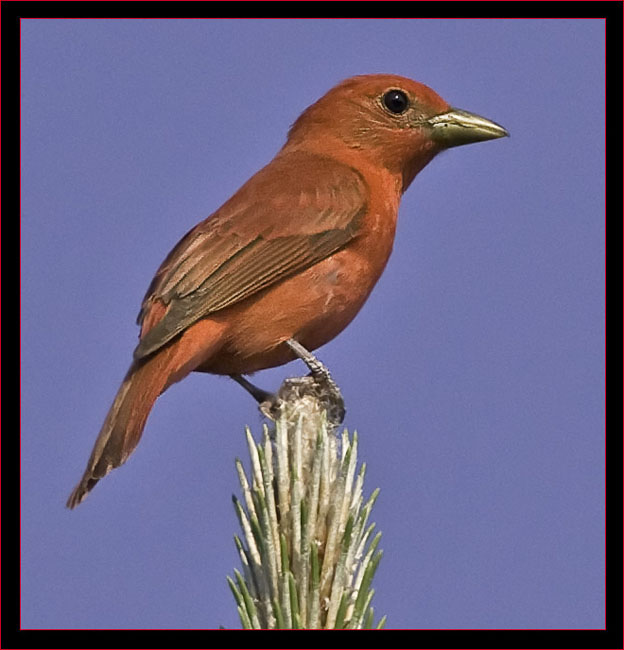
|
Hunter, Doug and I planned an excursion to Clyo, Georgia to the home and grounds of Jimmy & Ann Smith-Wilson. These really nice folks were known through the birding community connections and Doug had
recently been involved on a field trip to the site and wished to return, I don’t recall but Fitz either had plans or didn’t choose to make the trip with us this day. We left early to arrive in Clyo,
about a ninety-minute drive from Savannah in early light and spent multiple hours investigating the grounds. If you’ve reviewed any of my other articles you’ve probably figured out by now that many
subjects hold my interest. I will take the time to photograph anything that catches my eye and this day was no different. Although not from Skidaway Island, I’ll post a photo template from Clyo.
Summer Tanager image from our Clyo trip - 1Ds Mark III, 1/2500 second @ f/8, ISO 640 at 840mm |

|
|
Other than this one day the balance of our field time was spent somewhere on Skidaway Island. Most of these sessions weren’t of long duration but with the target rich environment
around The Landings they don’t necessarily have to be. We visited ‘the rookery’ on several occasions, generally in morning light allowing me to observe the progress of the Great
Egret hatchlings, who were nearly full sized by now.
Fitz was primarily interested in locating some of his non-feathered winged friends. Shooting at the rookery in morning light was his compromise to prevent a mutiny in the ranks – the ‘ranks’ being Doug and I of course. Later I realized the method in his madness... The temperature had to get up around 80 degrees before his favorite critters started on the wing so an early session of bird photography in his view worked out great followed by a switch over to seek butterflies and dragonflies. It wouldn’t have surprised me to learn he had a chart denoting the exact temperature by species and a portable thermometer on his golf cart he kept an eye on. He recognized we wouldn’t say much if he didn’t make us hunt bugs throughout the entire time. Fitz is indeed a crafty devil... Great Egret feeding young
|
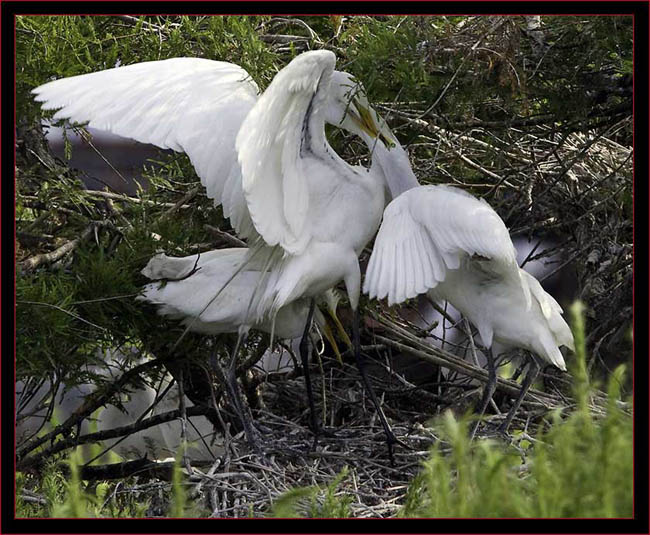
|
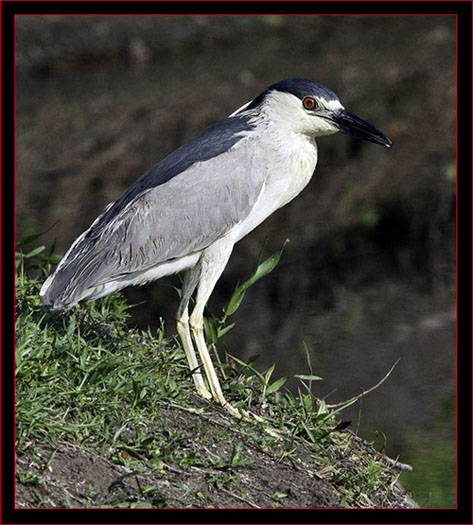
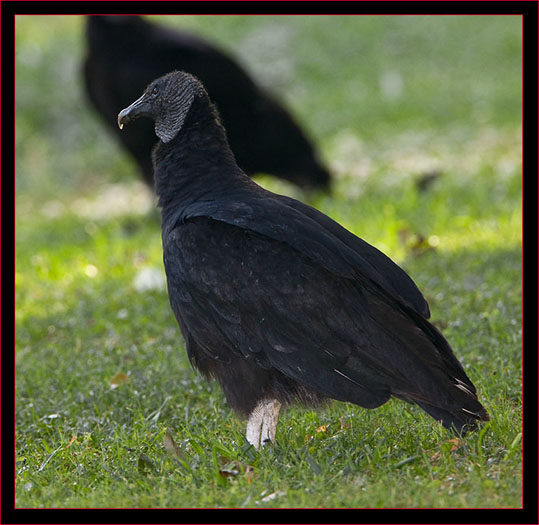
|
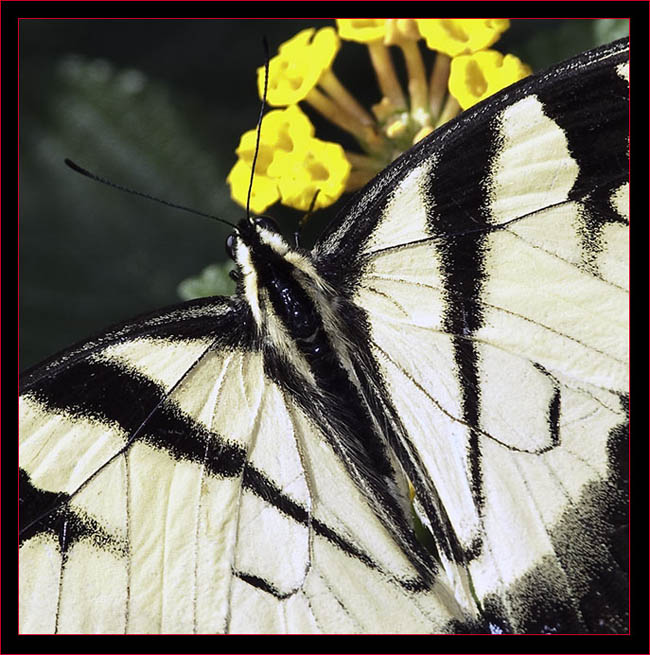
|
At this point I hope you have at least a marginal interest in some of the local insects found on Skidaway Island because the Bug Man took us down on the nature trail into a target rich environment for the
remaining sessions I had in Georgia. Fitz will photograph anything he likes as well these days as long as it crawls, creeps or flies about and can be photographed with his Canon 180mm f/3.5L Macro lens...
His study of host plants for various dragon & damselflies as well as butterflies was becoming such that he was a definite expert in these matters – compared to us he was a true connoisseur of bug life.
Whenever Doug and I got together with the cameras and Fitz we knew what to expect. We’d look at one another and decide if we wanted to shoot with shorter focal lengths or stay with longer lenses to
seek out birds. Hanging out with the Bug Man is always an experience and I opted to join him on the ‘golf cart patrol’ whenever I could. When we did this and Doug had time to go, he would follow
along in his cart and we stayed together.
Eastern Tiger Swallowtail - 1Ds Mark III, 1/2500 second @ f/8, ISO 640 at 840mm |
|
It wasn’t all insects though... One day on the golf cart as Fitz and I were patrolling we spotted a pair of Mississippi Kites in a tree. I jumped out of the cart with my 5d and 400mm lens
and got off three or four exposures before the birds were out of sight. None were exceptional by the one viewed at right is an excellent view of the Kite from behind.
Mississippi Kite - the first I'd ever photographed - Canon 5d/400mm f/5.6L lens, 1/1250 @f/5.6, ISO 640 handheld
|

|
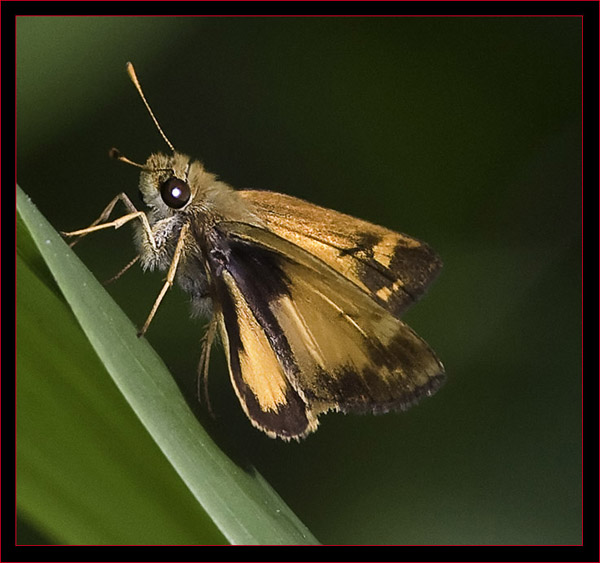
|
Male Zabulon Skipper on the nature trail - 1Ds Mark III, 1/2500 second @ f/11, ISO 3200 at 840mm with flash |
|
On one of these trips it was just Fitz and I in his golf cart. I figured we’d be shooting insects so didn’t bring my 600mm f/4 lens along as I normally would. There had been Barred Owl sightings
along the nature trail so we recognized they were in the area. We’d hope to spot one of these but so far had no luck whatsoever until this one particular day. As we hiked along heading to some
plantings that Fitz knew would be a likely butterfly patch, a pair of Barred Owls flew across the trail and into the woods. One kept going and was quickly out of sight. The other however, landed
fairly close by in a tree and in my line of sight. As usual whenever I failed to bring it along, I mentally kicked myself for not having the long lens and extender available to image this bird... At this range the shots would have obtained a
wonderful image scale. So, I thought about what I did have available, consisting of my 400mm F/5.6L lens and a 70~200 f/2.8L zoom, each on a camera body. I did have a flash head and tripod as well
so set up with as much reach as I had to capture this subject.
Barred Owl on the nature trail at 400mm - I think about how this would have looked at 840mm...
|
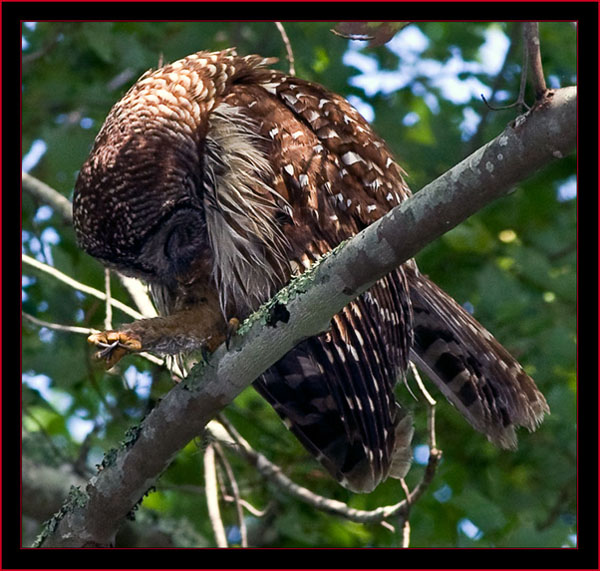
|

|
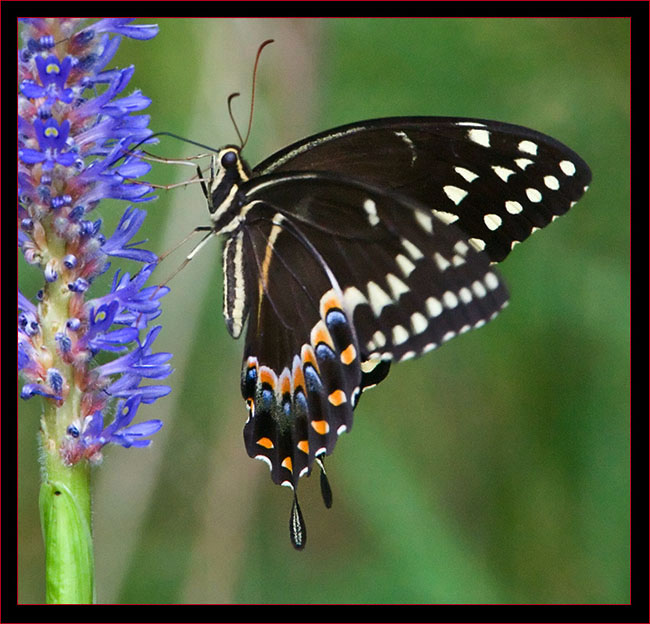
|
Palamedes Swallowtail on the nature trail - 1Ds Mark III, 1/250 second @ f/11, ISO 3200 at 840mm with flash |
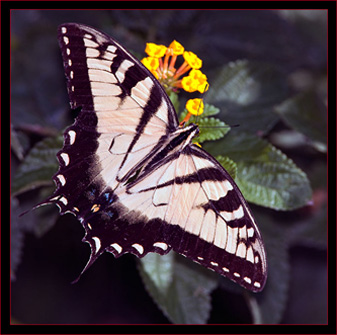
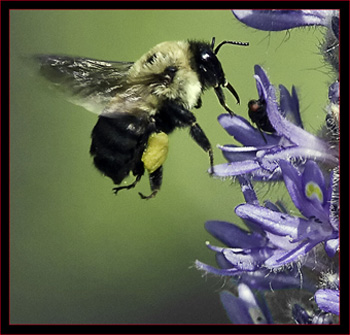
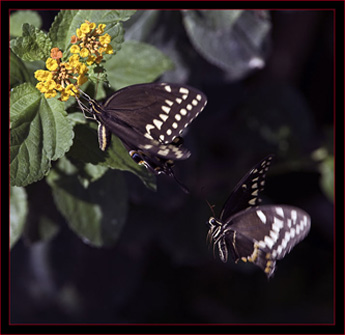
|
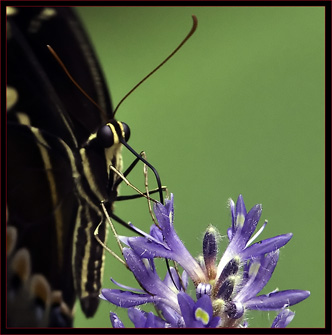
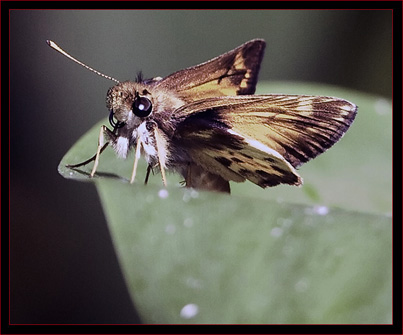
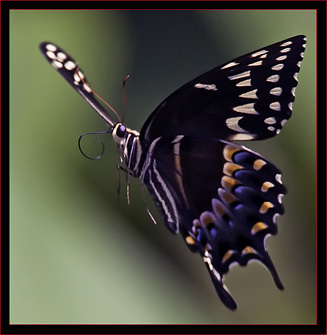
|
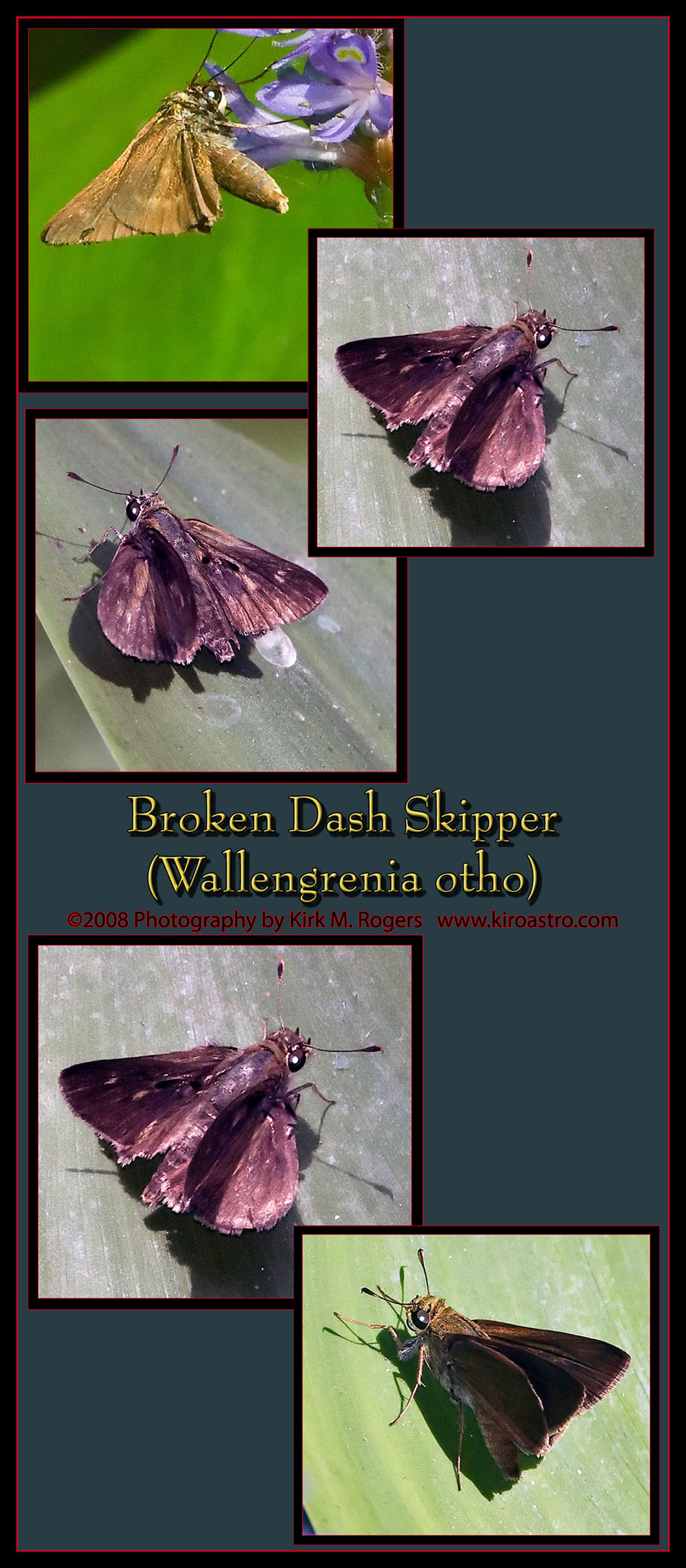
|
|
One can find all kinds of interesting subjects if you take time to investigate. I came across this small spider and set up to take a few shots. I’m developing a decent archive of spiders and web
shots and at some point may construct a website section to display this overall effort.
I photographed this Crablike Spiny Orb Weaver (Gasteracantha cancriformis) on one of our field trips
1Ds Mark III, 1/320 second @ f/8, ISO 800 at 840mm with flash |
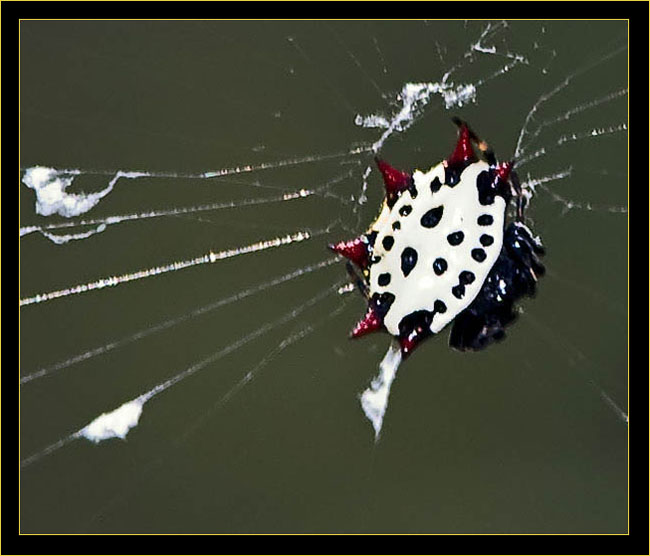
|
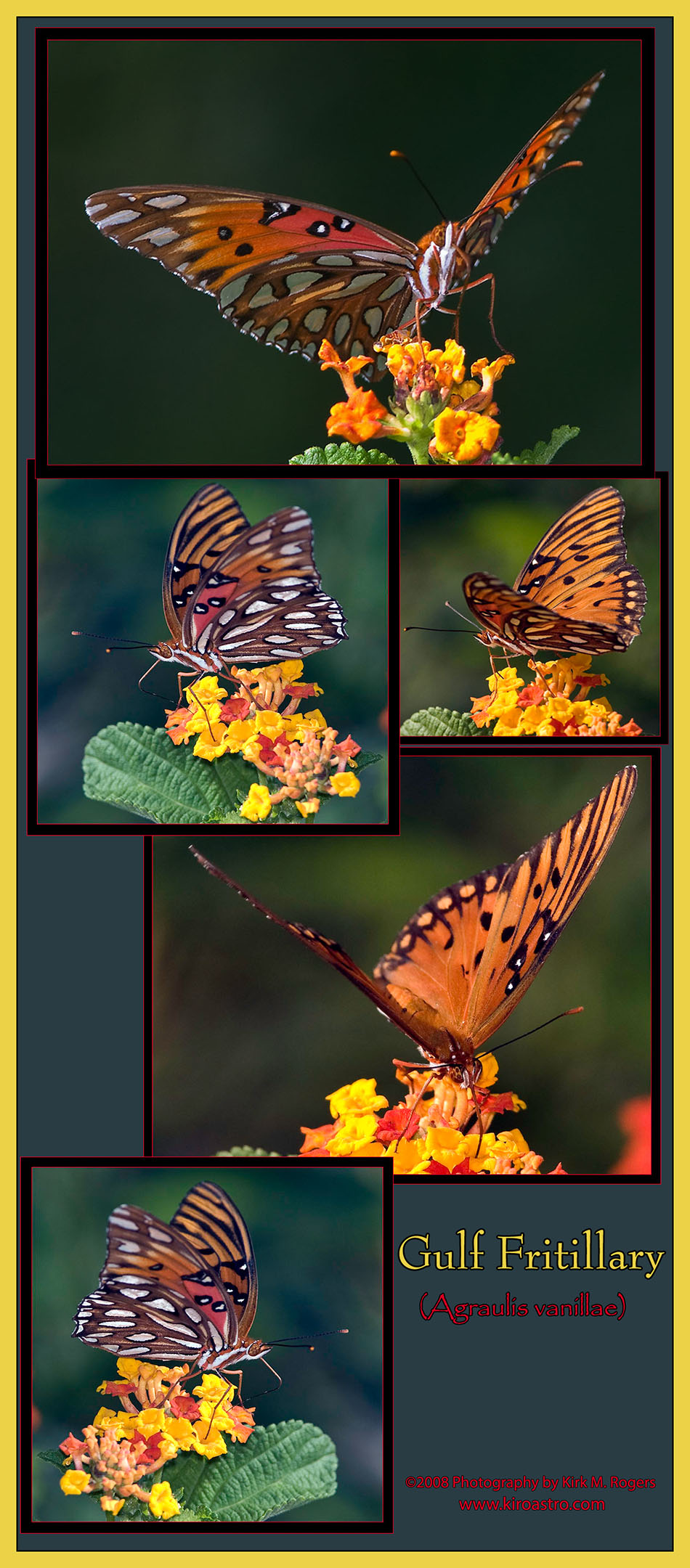
|
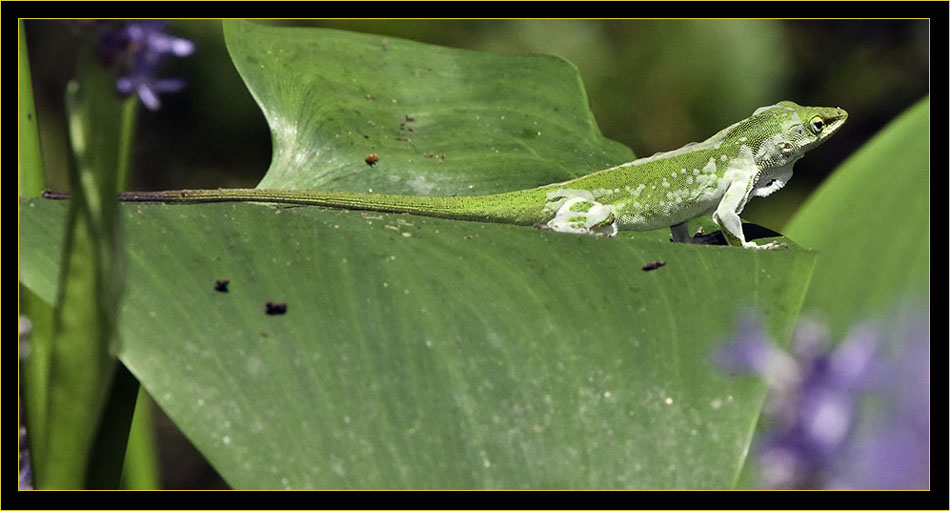
|
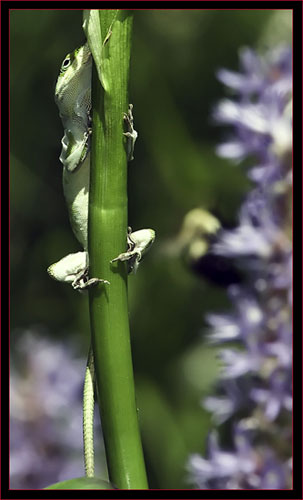
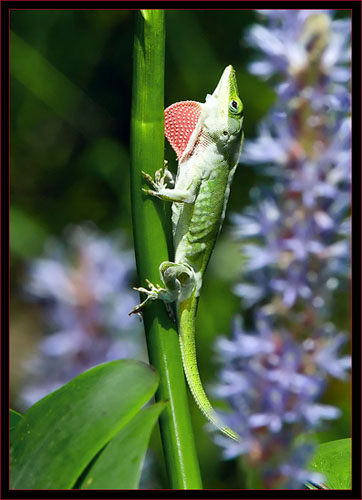
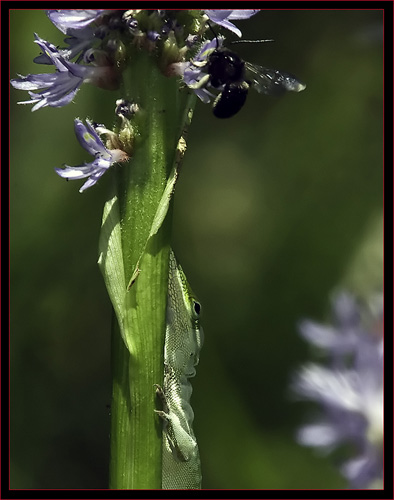
|

|
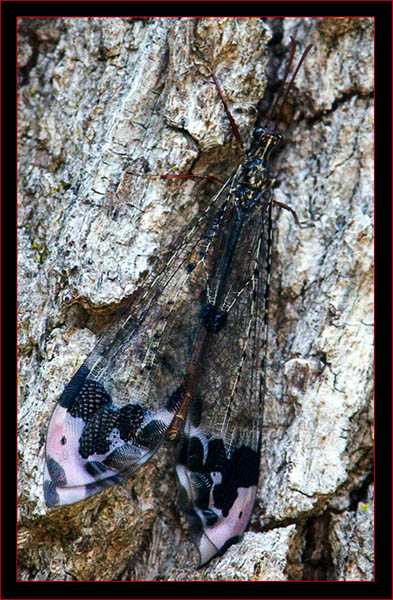
|
At the end of one of our sessions traveling along on the carts Fitz spotted this insect on a tree. Nobody had a clue what it was and for the life of me I couldn’t see this specimen with my naked eye.
Doug came over with his camera and took a few exposures and shortly afterwards I set my tripod up and attempted to do the same. As embarrassing as it was, I ended up asking Doug to get my lens
on the subject – I simply couldn’t see where it was. After he got my lens on it I was able to pick it out but it was difficult to see. Fitz reached out to some of his bug friends and came back
with a report that this was a Caddisfly... Okay Fitz if you say so... Anyway, at left is one of the images I took of this creature.
Caddisfly perched on a tree - 1Ds Mark III, 1/400 second @ f/10, ISO 3200 at 840mm with flash |
Palamedes (top) & Giant Swallowtail (bottom right) Butterflies in flight - Canon 1Ds Mark III, 1/1000 second @ f/16, ISO 3200 at 840mm with flash
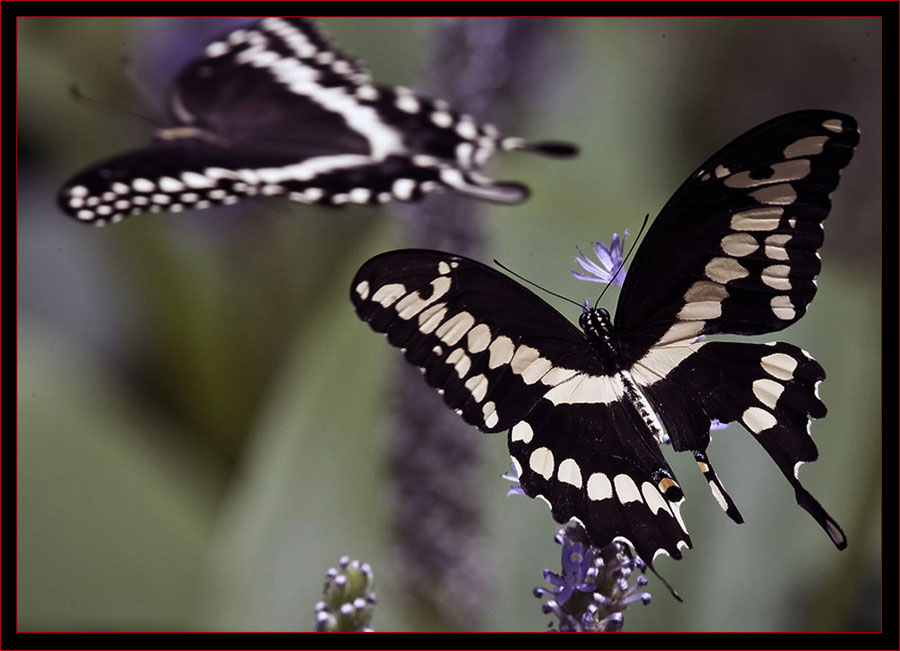
|
|
I have a considerable archive of dragonfly shots these days also, many of these photographed in the Savannah area. I wished to add to this group and was eager to put my new equipment to task in an attempt to see how it
compared to previous outings. Fitz of course, was up for this as well so he, Doug and I discussed where best to go to accommodate this effort. Before we were through I was pleased with the collective image
group from our field time.
Carolina Anole in transition - 1Ds Mark III, 1/800 second @ f/16, ISO 800 at 840mm with flash
|
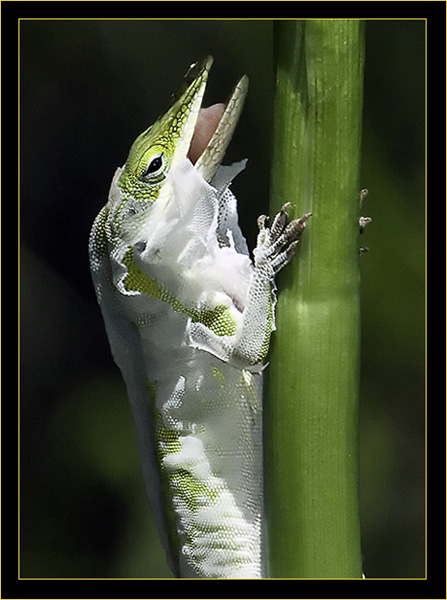
|
Here Come the Dragonflies...
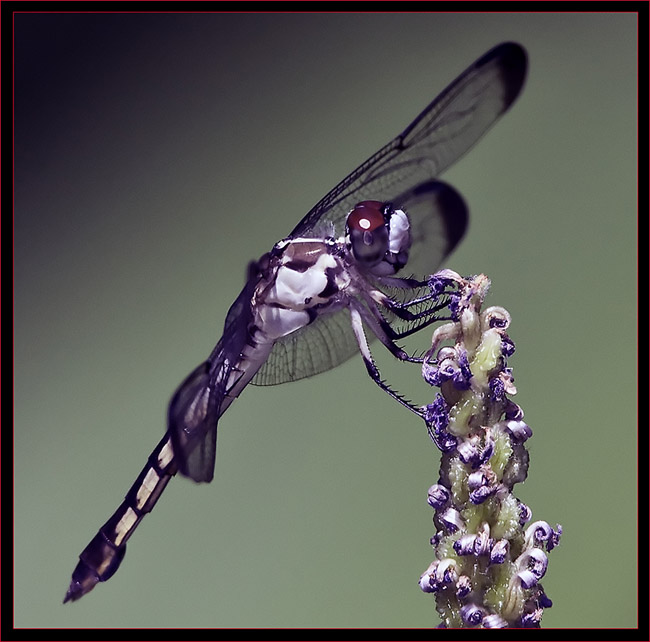
|
Immature male Great Blue Skimmer - Canon 1Ds Mark III, 1/2500 second @ f/8, ISO 3200 at 840mm with flash |
|
Adult male Banded Pennant - Canon 1Ds Mark III, 1/640 second @ f/10, ISO 640 at 840mm with flash
|
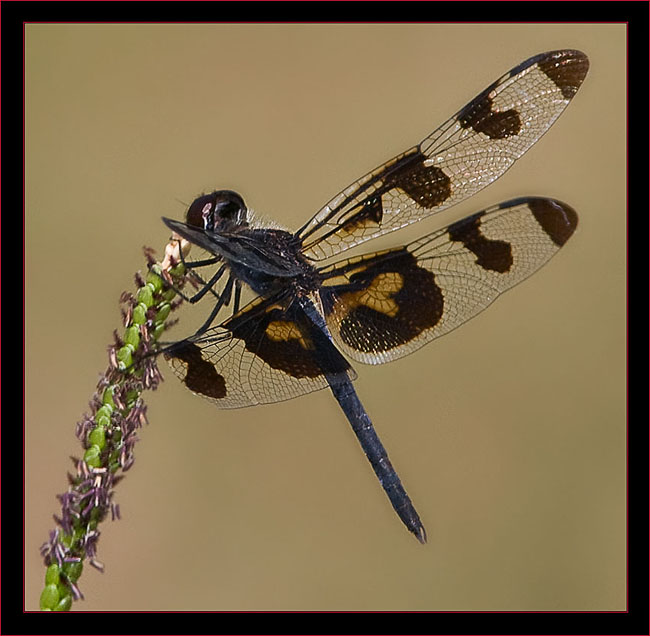
|
Great Blue Skimmer - Canon 1Ds Mark III, 1/1000 second @ f/8, ISO 3200 at 840mm with flash
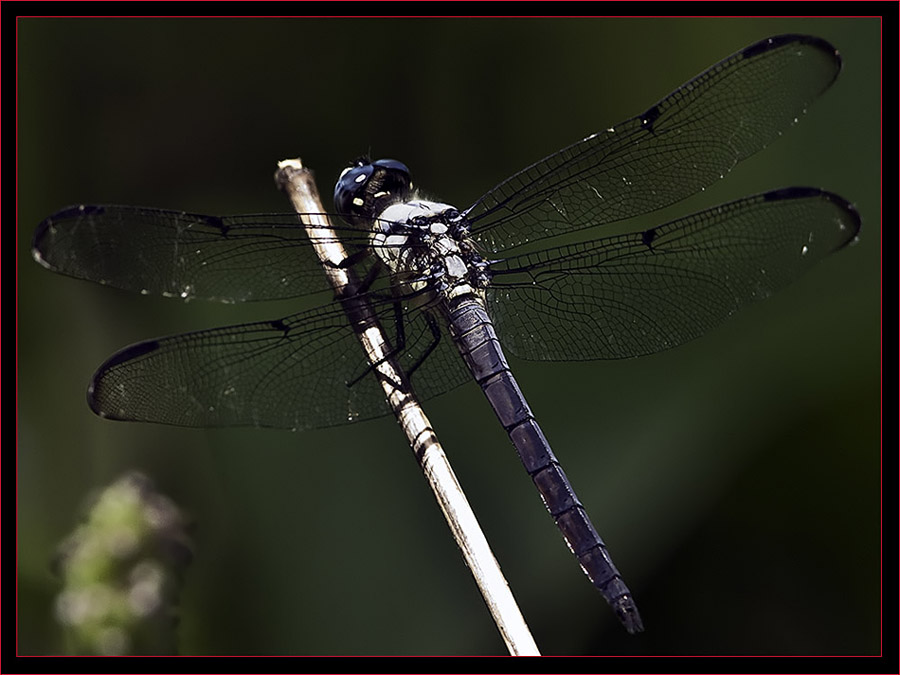
|
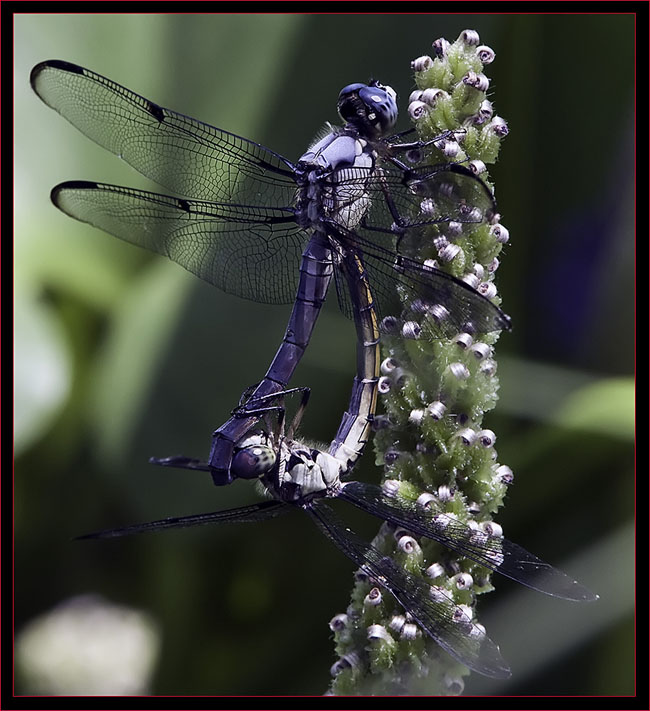
|
Dragonfly/Damselfly reproduction and associated behavior is unique among the animal world but universal within their species with some minor variations. Fitz explained much of this in
detail to us which left me duly impressed with his erudition on the subject - Yikes!. Doug on the other hand thought we should buy Fitz some golf clubs or something so he’d get out more to
create other avenues of interest...
Great Blue Skimmers in the Wheel Mating Position - Canon 1Ds Mark III, 1/200 second @ f/16, ISO 3200 at 840mm with flash |
Female Eastern Pondhawk - Canon 1Ds Mark III, 1/250 second @ f/16, ISO 3200 at 840mm with flash
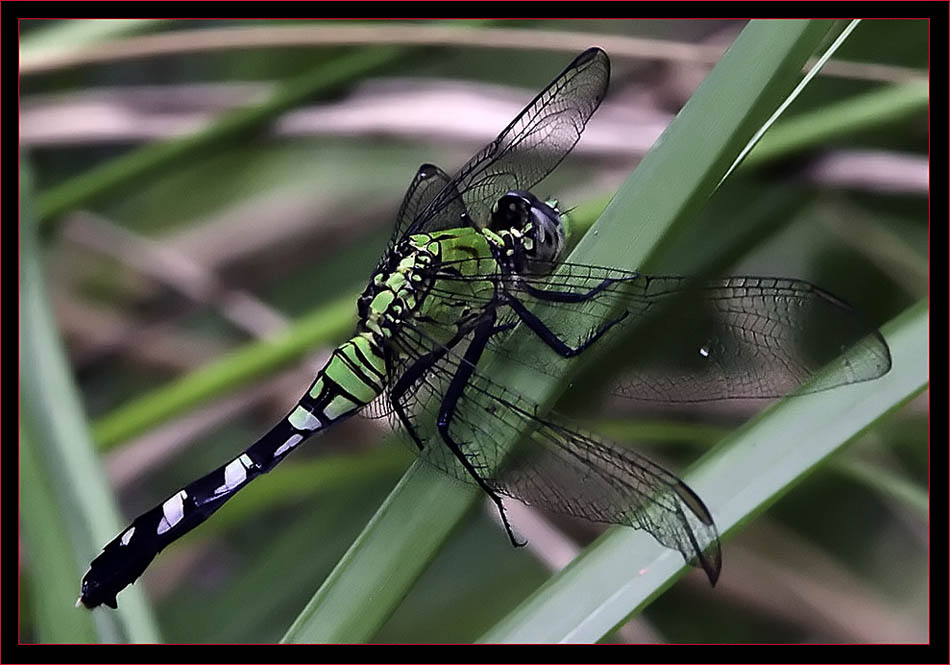
|
|
One warm Georgia mid-morning (downright hot to me) as Doug, Fitz and I were driving around in my pickup on a photography junket, Fitz indicated he needed to buy some batteries for his hearing aids.
So we left The Landings and drove to the nearby general store so he could make his purchase.
Fitz is always prepared and makes certain he has sufficient power before we get out in the middle of wherever to learn there could be an issue...
As stated it was hot – I remained in the truck with the air conditioner blasting before we moved on to the next
photographic site. As we left the parking area and entered the roadway, there was a border of grass with a sidewalk that ran down to a lagoon. I noticed a dragonfly perched on a stem and pulled
over to take a look. To Doug and I this was just another perched insect, but to Fitz it was an entirely different matter... I could tell by his excitement that this find must be unusual so we
all got out with our cameras to investigate further. The end result of this activity was that we’d found and imaged a Banded Pennant dragonfly, apparently an addition to the Chatham County list
and Fitz was more than pleased. The following statement was excerpted from an email Fitz sent out that evening announcing the find: “Our find today of the Banded Pennant will be added to the Chatham list. Good spotting Kirk. From here, to the end of time, it will be known as, ‘Kirk's Skidaway Banded Pennant’.” Being famous has proven difficult at times with all the well-wishers & public interest but I’ve been able to handle the celebrity fairly well to date ... Banded Pennant - Canon 1Ds Mark III, 1/500 second @ f/10, ISO 1000 at 840mm
|
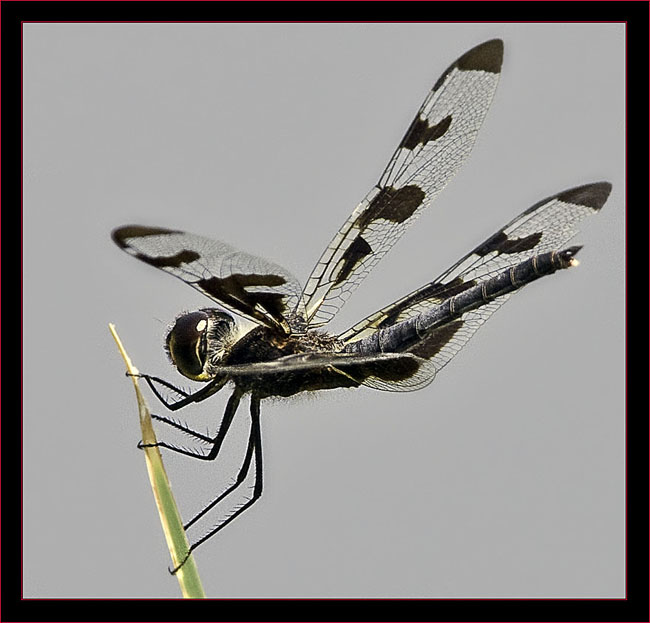
|
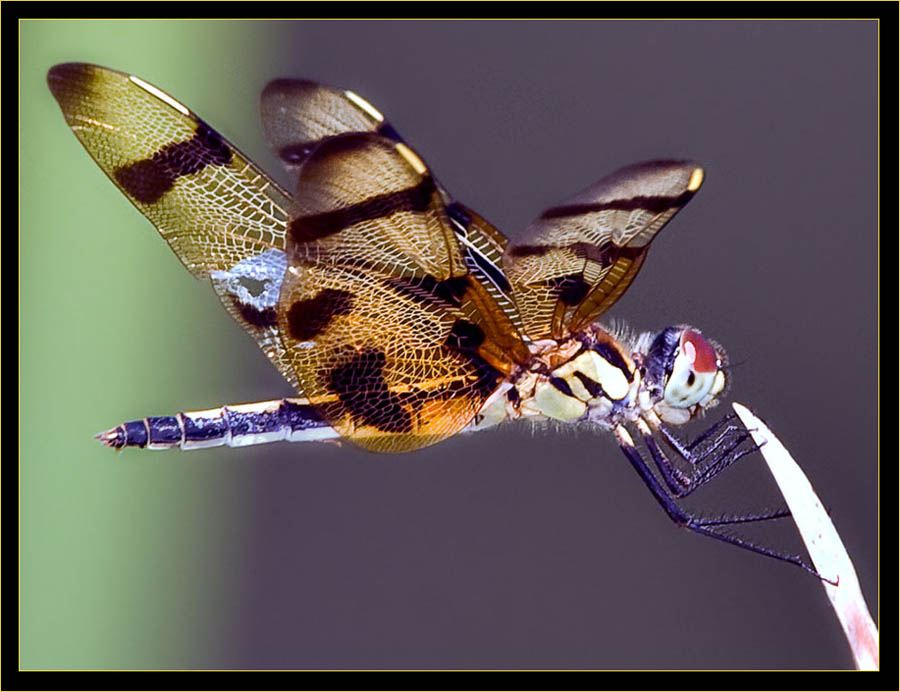
|
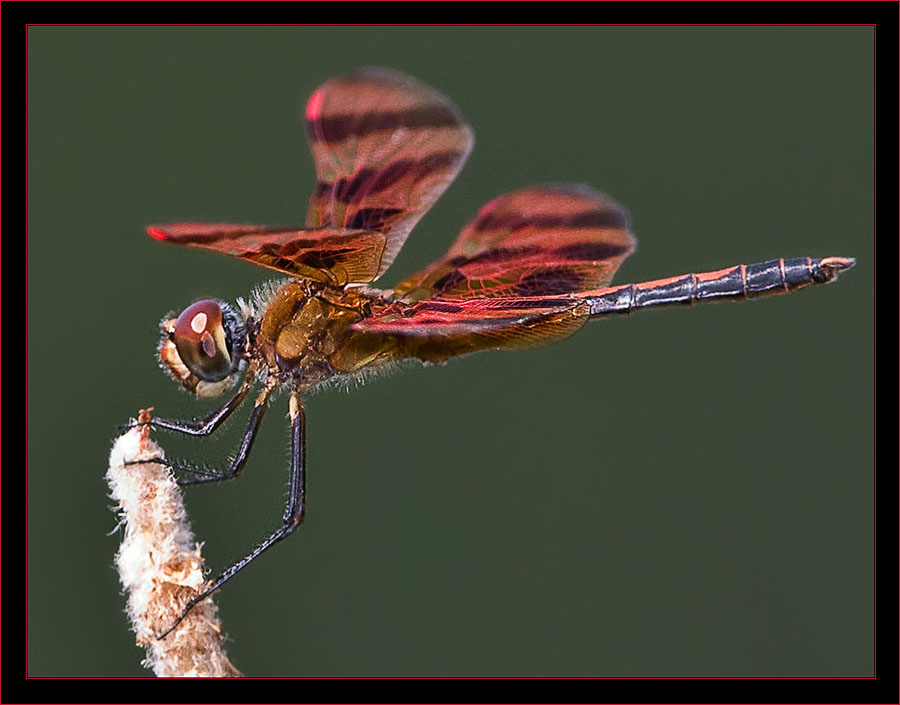
|
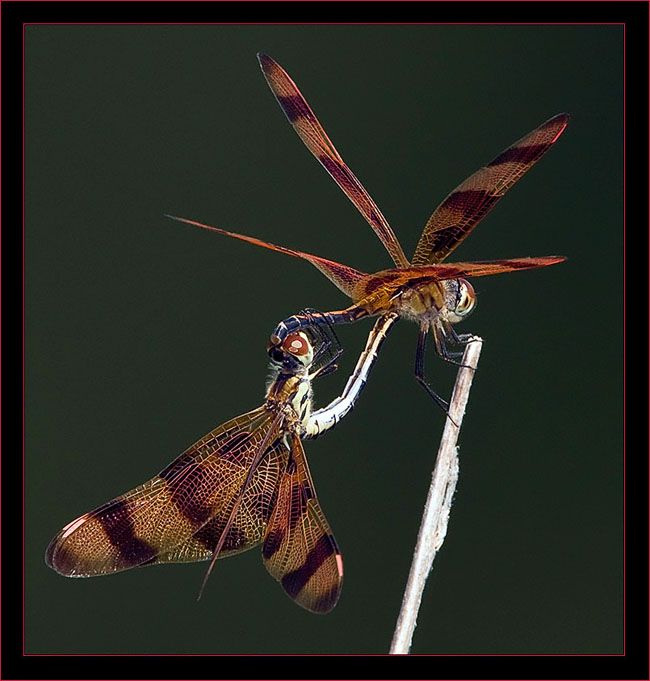
|
Halloween Pennant Dragonflies in the Wheel Mating Position - Canon 1Ds Mark III/600mm f/4L lens extended to 840mm, 1/320 second @ f/16, ISO 1000 with flash |
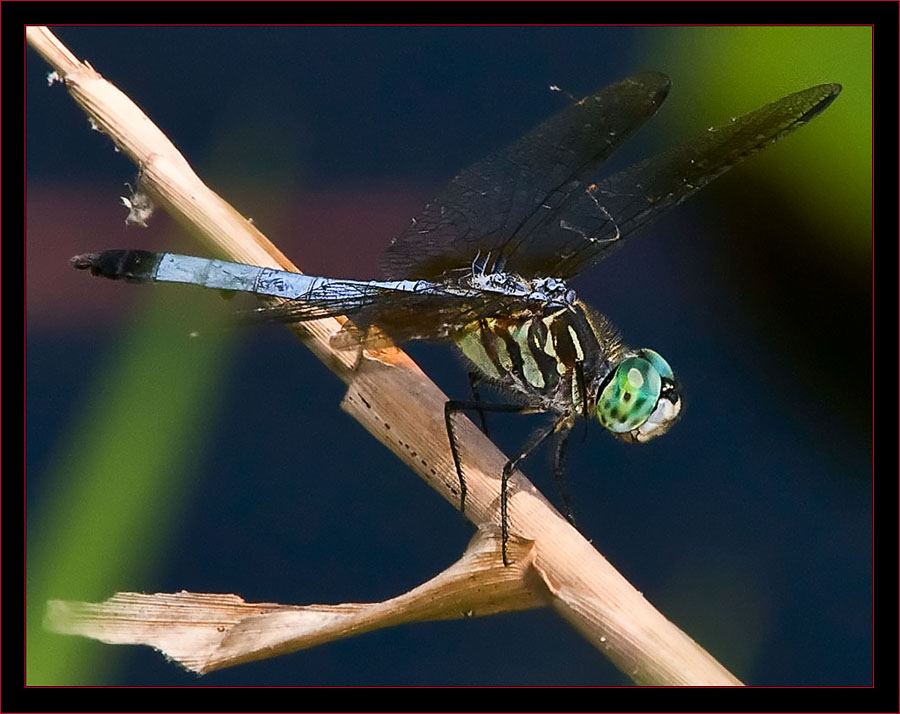
|
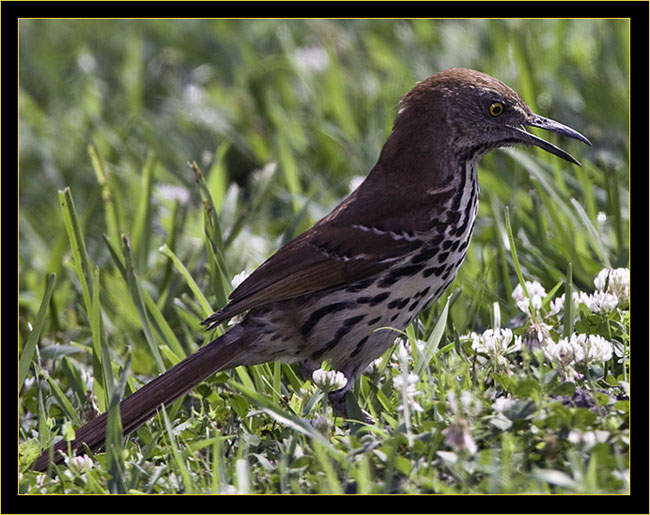
|
Yes - I recognize this isn’t a dragonfly but this Brown Thrasher – the state bird of Georgia, was frolicking about near where the Banded Pennant was photographed.
I moved my tripod over to close the distance and took a few exposures on this bird. Although there are many of these around, obtaining a good image isn’t always
easy as they often don’t break cover.
Brown Thrasher - Canon 1Ds Mark III, 1/320 second @ f/10, ISO 640 at 840mm with flash |
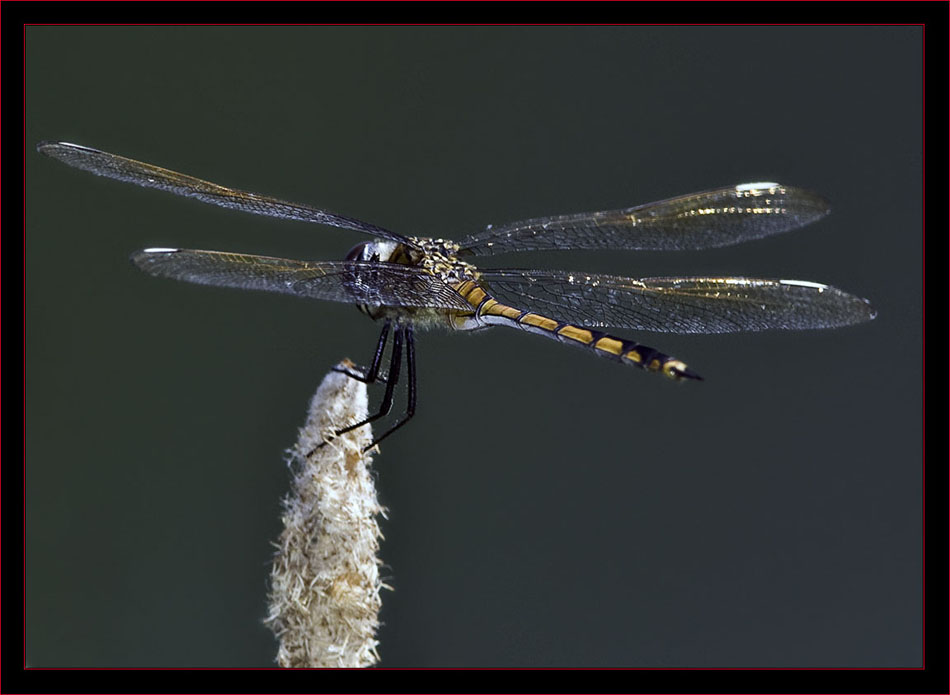
|
|
I’m often asked about the value of using fill flash in the type of shooting I do. It wasn’t all that long ago that I really wasn’t particularly interested in using flash. This was mostly because
it adds a degree of awkwardness to one’s system in the field to transport with an extender as in bird photography. However, I have come to recognize the benefit this can add to an image and I’ll
always use one of my flash heads off camera on my tripod mounted system. I’ve attempted using a flash and extender on my handheld system but have given this up as too weighty and awkward to use
and carry. Fill flash brings out the color of the subject far beyond an image shot in natural light will in most cases like in the forest for example. I’ve found this to be the case especially
with subjects like warblers and dragonflies. You won’t require a flash extender for insect shots because of the need to close the working distance but much depends on your equipment and site conditions.
Male Needham's Skimmer - Canon 1Ds Mark III, 1/1000 second @ f/16, ISO 1000 at 840mm
|
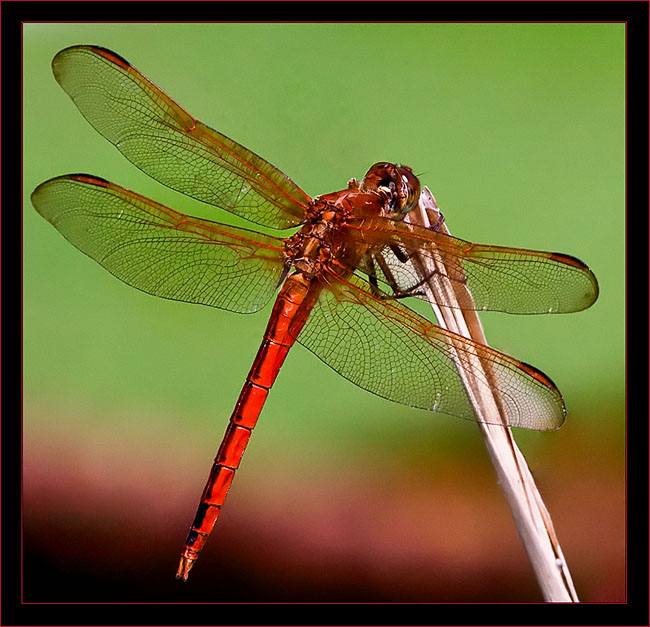
|
Carolina Saddlebags in flight
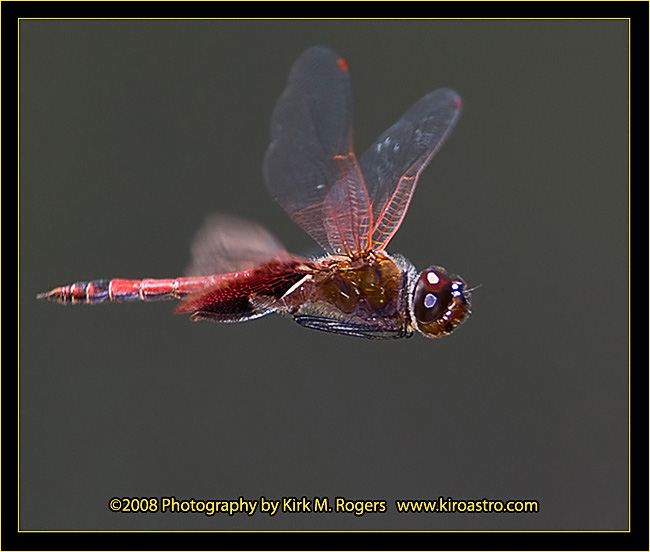
|
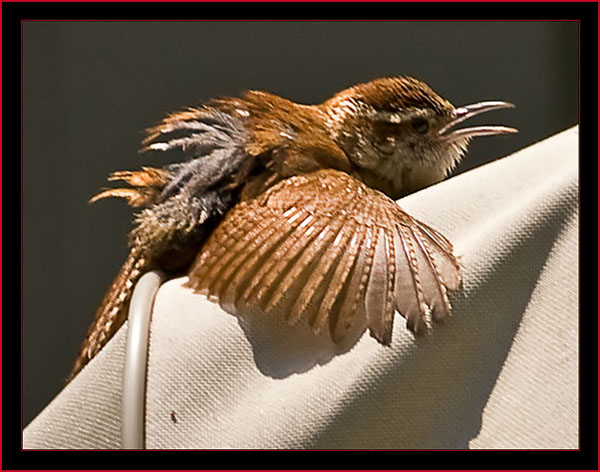
|
When Fitz and I returned to his house one afternoon we found this Carolina Wren in his backyard doing some kind of antics on his covered
grill... Canon 5d/400mm f/5.6L lens, 1/1000 second @ f/8, ISO 400 handheld I truly missed the camaraderie I’d shared with all my friends new and old upon my return to Maine. I’ve indicated to them previously that I don’t have anyone their equal at home to share my camera time and generally pursue these endeavors as an isolated adventure. |
As I close out this photojournal of my time on Skidaway Island, I’d like to dedicate this humble effort to my Savannah friends and to Linda for bearing up so well under a long Maine winter in my absence.
| Bill & Ms. Rosalie – I thank you profusely for all the kindness and consideration you so graciously exhibited during my time at The Landings as I came and went. Being ‘part of the family’ was interesting and I enjoyed spending time with the boys. Ms. Rosalie – I know you weren’t impressed when I stated Bill needed to come stay with us for a month or two in reciprocation, but he and all of you would be welcome again... |
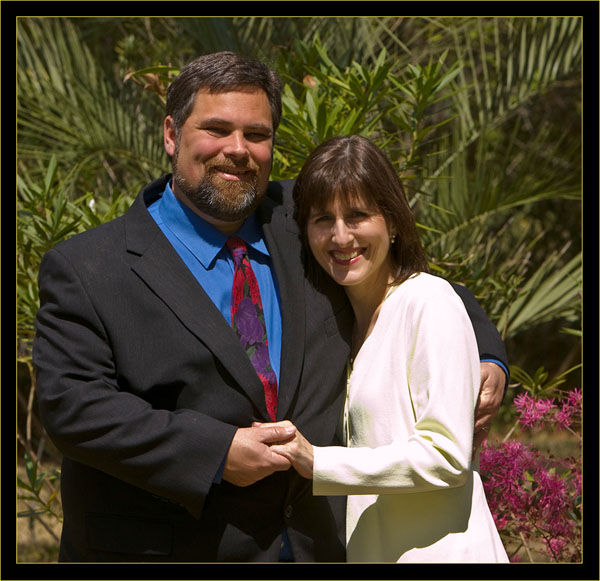
|

|
Fitz took this 40d image of Ms. Diana observing shorebirds as I was photographing the flock as they moved about. Getting out with master birder Diana Churchill is always fun and informative. Thanks for sharing your time and knowledge Diana... |
|
My new found friend Hunter Kennedy turned out to be an interesting, articulate, knowledgeable fellow and a good photographer. Unlike some others who shall remain nameless, I actually believe there’s a
good chance I may see Hunter in Maine at some point... Spending time in the field with you was great Hunter – Thanks!
My 5d image of Hunter on our field day in Clyo. I laughed when I re-opened this file – I’d entitled it, 'A Manly Man of Action'. Suitable however...
|
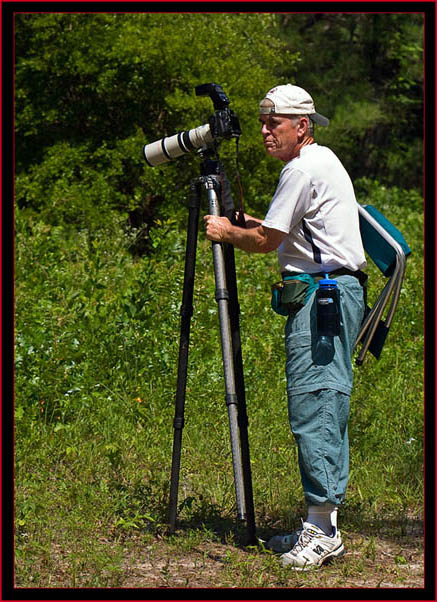
|
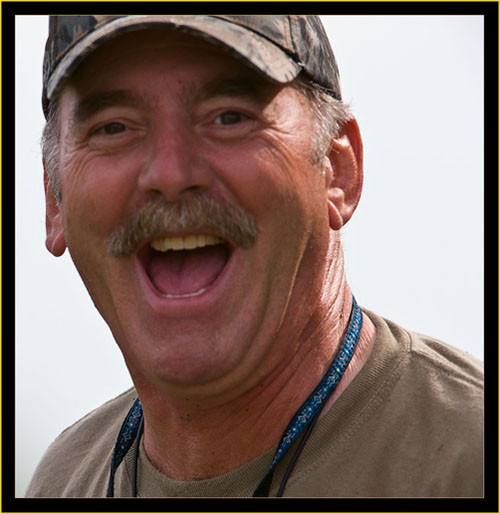
|
At left is one of my few images of Doug Herrick taken in April ’08 on one of our excursions. I believe it was to the Savannah National Wildlife Refuge when Fitz, Doug and were traveling together.
Because we rarely document group members we got in the habit of taking a few people images now and then. This isn’t as simple as one may think; most of the time we shoot with long focal lengths
so you require some distance from the subject unless you want a close up of somebody’s nose or similar... I do believe this image does well in capturing Doug's essence – he’s a good man.
I think so highly of Doug I could create a separate article just about him if I took the time. Although he hails originally from Massachusetts – you’d need to have an understanding of the Maine/Mass dynamic to be in on the joke, I consider him a good friend and photographic peer. We had many fun adventures together when I was in Georgia – even the day at Tybee Island when the photographic gear got washed out into the channel – excluding this incident - was a great day. I appreciate that you would take time away from your golf pursuits to get out with the camera Doug – thanks! |
|
Last but far from least is my friend, the Bug Man of Skidaway Island - Fitz Clarke, viewed here in my shot doing what he likes best – photographing insects...
Fitz retired to The Landings with his spouse Ms. Becky after a lengthy career with the Federal Bureau of Investigation. He indicated he’d received his early photographic training from his days with the Bureau. All I can tell you is that spending time with Fitz is a real hoot and there is much about him I admire. I found him to be an affable, conscientious fellow and a photographer of outstanding merit. Thanks for your time and our shared adventures Fitz; it was a great deal of fun... I know I’ll have to return to Georgia if I ever wish to see your smiling face again after your comment about, 'never again going north of the Mason-Dixon Line'... |
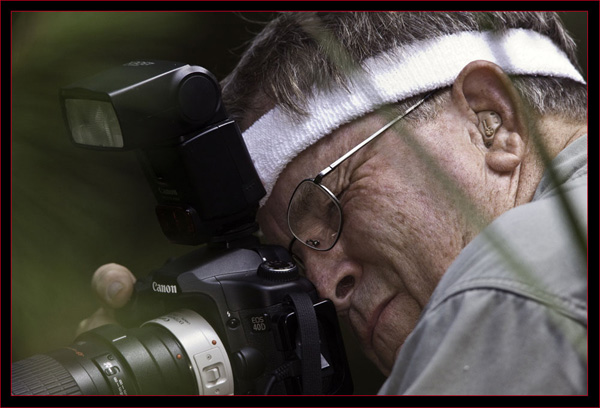
|
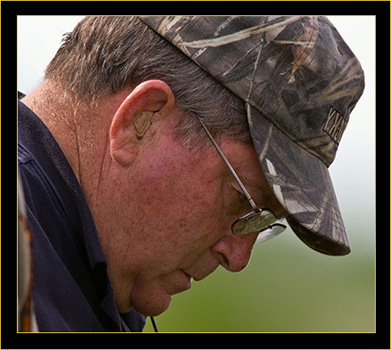
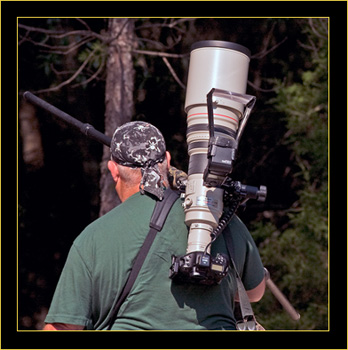
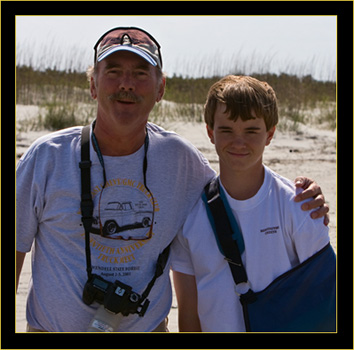
|
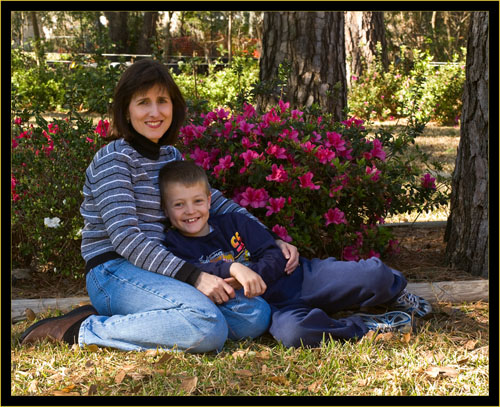

|